Related Research Articles

Memphis or Men-nefer was the ancient capital of Inebu-hedj, the first nome of Lower Egypt that was known as mḥw ("north"). Its ruins are located near the modern town of Mit Rahina, 20 km (12 mi) south of Giza in Greater Cairo, Egypt.

Tanis or San al-Hagar is the Greek name for ancient Egyptian ḏꜥn.t, an important archaeological site in the north-eastern Nile Delta of Egypt, and the location of a city of the same name. It is located on the Tanitic branch of the Nile, which has long since silted up. The first study of Tanis dates to 1798 during Napoléon Bonaparte's expedition to Egypt. Engineer Pierre Jacotin drew up a map of the site in the Description de l'Égypte. It was first excavated in 1825 by Jean-Jacques Rifaud, who discovered the two pink granite sphinxes now in the Musée du Louvre, and then by François Auguste Ferdinand Mariette between 1860 and 1864, and subsequently by William Matthew Flinders Petrie from 1883 to 1886. The work was taken over by Pierre Montet from 1929 to 1956, who discovered the royal necropolis dating to the Third Intermediate Period in 1939. The Mission française des fouilles de Tanis (MFFT) has been studying the site since 1965 under the direction of Jean Yoyotte and Philippe Brissaud, and François Leclère since 2013.
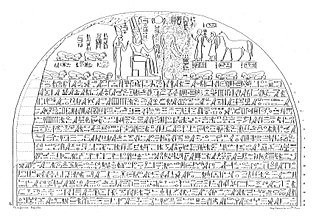
Piye was an ancient Kushite king and founder of the Twenty-fifth Dynasty of Egypt, who ruled Egypt from 744–714 BC. He ruled from the city of Napata, located deep in Nubia, modern-day Sudan.
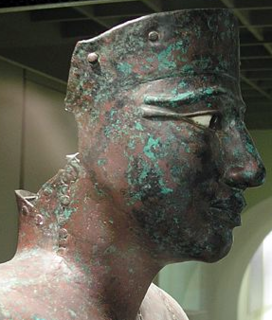
Pepi I Meryre was an ancient Egyptian pharaoh, third king of the Sixth Dynasty of Egypt, who ruled for over 40 years at the turn of the 24th and 23rd centuries BC, toward the end of the Old Kingdom period. He was the son of Teti, the founder of the dynasty, and ascended the throne only after the brief intervening reign of the shadowy Userkare. His mother was Iput, who may have been a daughter of Unas, the final ruler of the preceding Fifth Dynasty. Pepi I, who had at least six consorts, was succeeded by his son Merenre Nemtyemsaf I, with whom he may have shared power in a coregency at the very end of his reign. Pepi II Neferkare, who might also have been Pepi I's son, succeeded Merenre.
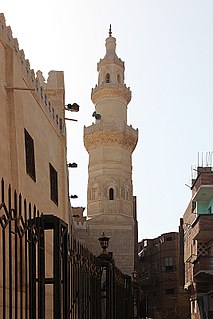
Akhmim is a city in the Sohag Governorate of Upper Egypt. Referred to by the ancient Greeks as Khemmis or Chemmis and Panopolis, it is located on the east bank of the Nile, four miles (6.4 km) to the northeast of Sohag.

Jebel Barkal or Gebel Barkal is a mesa or large rock outcrop located 400 km north of Khartoum, next to Karima in Northern State in Sudan, on the Nile River, in the region that is sometimes called Nubia. The jebel is 104 m tall, has a flat top, and came to have religious significance for both ancient Kush and ancient Egyptian occupiers. In 2003, the mountain, together with the extensive archaeological site at its base, were named as the center of a World Heritage Site by UNESCO. The Jebel Barkal area houses the Jebel Barkal Museum.

Djedkare Isesi was a pharaoh, the eighth and penultimate ruler of the Fifth Dynasty of Egypt in the late 25th century to mid-24th century BC, during the Old Kingdom. Djedkare succeeded Menkauhor Kaiu and was in turn succeeded by Unas. His relationship to both of these pharaohs remain uncertain, although it is often conjectured that Unas was Djedkare's son, owing to the smooth transition between the two.
Qift is a small town in the Qena Governorate of Egypt about 43 km (27 mi) north of Luxor, situated under 26° north lat., on the east bank of the Nile. In ancient times its proximity to the Red Sea made it an important trading emporium between India, Punt, Felix Arabia and the North. It was important for nearby gold and quartzite mines in the Eastern Desert, and as a starting point for expeditions to Punt.

The Institut français d'archéologie orientale, also known as the French Institute for Oriental Archaeology in Cairo, is a French research institute based in Cairo, Egypt, dedicated to the study of the archaeology, history and languages of the various periods of Egypt's civilisation.
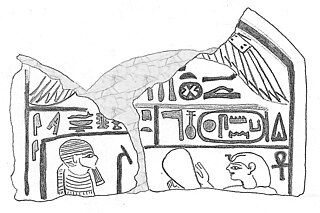
Semenkare Nebnuni is a poorly attested pharaoh of the early 13th Dynasty during the Second Intermediate Period. According to Egyptologists Darrell Baker and Kim Ryholt, Nebnuni was the ninth ruler of the 13th Dynasty. Alternatively, Jürgen von Beckerath and Detlef Franke see him as the eighth king of the dynasty.

Nubkheperre Intef was an Egyptian king of the Seventeenth Dynasty of Egypt at Thebes during the Second Intermediate Period, when Egypt was divided by rival dynasties including the Hyksos in Lower Egypt.

Neferkauhor Khuwihapi was an ancient Egyptian pharaoh of the Eighth Dynasty during the early First Intermediate Period, at a time when Egypt was possibly divided between several polities. Neferkauhor was the sixteenth and penultimate king of the Eighth Dynasty and as such would have ruled over the Memphite region. Neferkauhor reigned for little over 2 years and is one of the best attested kings of this period with eight of his decrees surviving in fragmentary condition to this day.
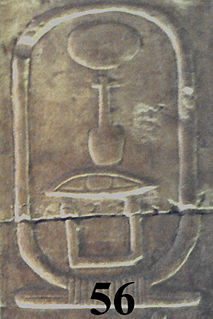
Neferirkare was an ancient Egyptian pharaoh of the Eighth Dynasty during the early First Intermediate Period. According to the egyptologists Kim Ryholt, Jürgen von Beckerath and Darrell Baker he was the 17th and final king of the Eighth Dynasty. Many scholars consider Neferirkare to have been the last pharaoh of the Old Kingdom, which came to an end with the 8th Dynasty.

Seuserenre Bebiankh was a native ancient Egyptian king of the 16th Theban Dynasty during the Second Intermediate Period and, according to Kim Ryholt, the successor of king Semenre. He is assigned a reign of 12 years in the Turin Canon (11.8).
Bebiankh was succeeded either by a poorly known king named Sekhemre Shedwast or by the equally shadowy ruler Seneferankhre Pepi III.
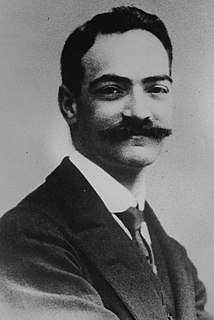
Adolphe Joseph Reinach was a French archaeologist and Egyptologist who participated in excavations in Greece and Egypt and published works on the Gauls.
The Coptos Decree of Nubkheperre Intef is a legal ruling written in hieroglyphic on the wall of the Min-temple in Coptos.
Hornakht was an ancient Egyptian official living at the end of the Second Intermediate Period. His title was royal acquaintance access. He is known in Egyptology because his burial was found undisturbed. It was discovered on 21 December 1862 by Luigi Vassalli who worked for Auguste Mariette in Dra' Abu el-Naga' at Thebes. Gaston Maspero published the tomb group in 1892. The burial contained the rishi coffin of Hornakht and a set of objects, some of them inscribed with the names of other officials some of these objects perhaps gifts to Hornakht. There was a throw stick with the name of king Seqenenre Djehuty-aa also inscribed with the name of the king's son Tjuiu. The object provides an idea of Hornakht's dating. A box bears the name of the mayor Minemhat and there was a cosmetic spoon inscribed with the name and title of the mayor of Hierakonpolis Sobeknakht. These people are all most likely contemporary with Hornakht. A vase bears the name of an Idi and dates most likely to the Old Kingdom. Other objects found in the tomb are scarabs, stone vessels, a pair of sandals, a headrest and a gaming board.
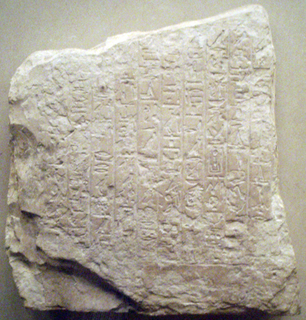
The Coptos Decrees are 18 complete or fragmentary ancient Egyptian royal decrees ranging from the 6th Dynasty to the late 8th Dynasty. The decrees are numbered with letters of the Latin alphabet, starting with "Coptos Decree a" and ending with "Coptos Decree r". The earliest of the series were issued by Pepi I and Pepi II Neferkare to favor the clergy of the temple of Min, while the others are datable to the reign of various kings of the 8th Dynasty, and concern various favors granted to an important official from Coptos named Shemay and to his family members. The decrees reflect the waning of the power of the pharaoh in the early First Intermediate Period.

Shemay was an ancient Egyptian official and later vizier toward the end of the 8th Dynasty during the First Intermediate Period, mainly known for being the beneficiary of most of the Coptos Decrees. His career has been interpreted as a glaring sign of the extreme weakness of the central power, forced to bestow great privileges to maintain the loyalty of powerful local governors. Shemay is buried in a mudbrick mastaba just south of Coptos.

Idy was an important Ancient Egyptian official in the Eighth Dynasty known from several sources. He lived at the beginning of the First Intermediate Period and was the son of Shemay, who is also known from several monuments and decrees from Koptos. His mother was the king's daughter Nebet. Idy appears on many royal decrees found at Koptos. There he bears the important title of a vizier, but was also overseer of Upper Egypt and overseer of priest and count. The decrees are dated under king Neferkauhor and Neferirkare. One decree is addressed to Shemay and dates under Neferkauhor. It reports the appointment of Idy to the overseer of Upper Egypt. A second one mentions affairs in the temple of Min at Koptos. In a third decree Idy bears the titles of a vizier. In the decree, the king protects the statues and the funerary cult of Idy. The decree is dated under king Neferirkare, who was the successor of Neferkauhor. It seems that Idy took over many positions that his father hold before.
References
- ↑ G. Castel and G. Soukianssian: "Dépôt de stèles dans le sanctuaire du Nouvel Empire au Gebel Zeit", in: BIFAO 85 (1985), 285–93.
- ↑ A. Mariette: Monuments divers recueillis en Egypte et en Nubie par Auguste Mariette-Pacha. Ouvrage publie sous le auspices de S.A. Ismaile Paha Khedivve d'Egypte, Texte par G. Maspero, Paris 1892, pl. 51